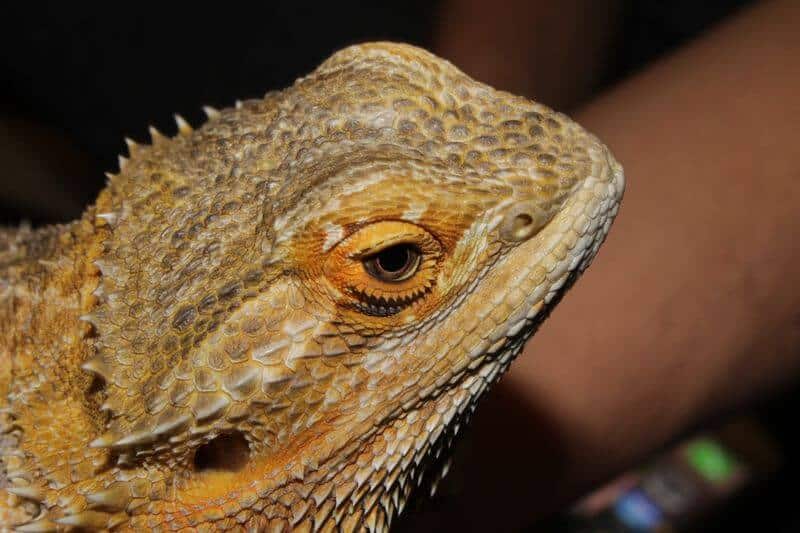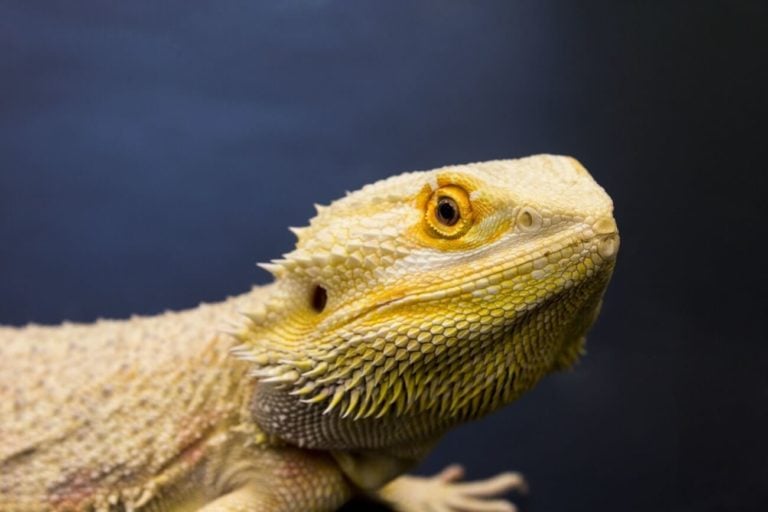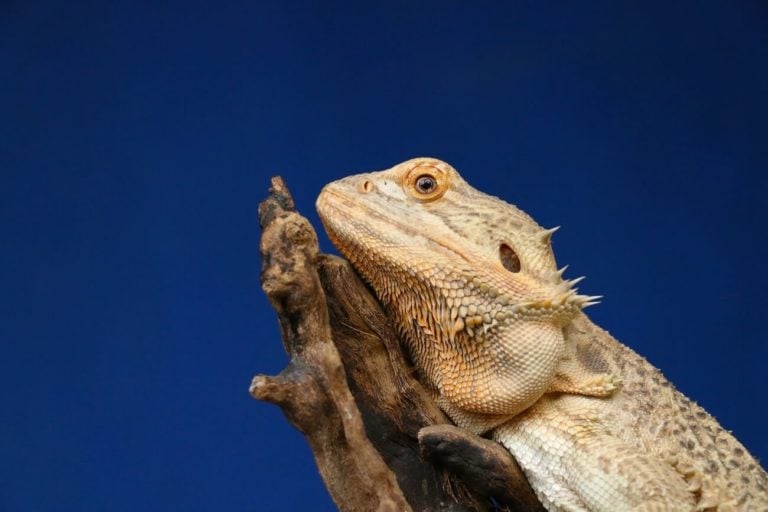Bearded dragon nose plugs are an interesting occurrence that many new owners don’t understand. And when you add that to the heaps of bad advice you see online, it results in them taking the wrong action.
This guide will teach you everything you need to know about nose plugs on bearded dragons, and what you should do about them.
Table of Contents
What Are Bearded Dragon Nose Plugs?
If you look at your bearded dragon’s head closely, you’ll notice small openings on the snout. Those are the lizard’s nostrils!
Like every other land-dwelling animal, bearded dragons need to breathe. The two nostrils on the reptile’s head are what they use to take in air. The function is similar to your own nostrils, but there are a few key differences.
Bearded dragons have long tubular nostrils that can open and close as they see fit. The unique design is important to the reptile’s health and comfort. It helps prevent unwanted dirt or water from entering. The long nostrils also help keep food and debris from getting into their system and causing irritation.
For the most part, the nostrils function well. But occasionally, they may experience a plug!
Nose plugs are a common issue among bearded dragons. They occur whenever something gets into the tubular nostrils, clogging them and preventing air from passing normally.
Many different things can plug the nostrils, but most clogged nostrils are a byproduct of inefficient shedding.
Bearded dragons will shed several times throughout their lives. Juveniles can shed every few weeks, gradually doing it less as they reach maturity. A full-grown beardie will only shed a couple of times a year.
The process has to do with growth. During a shed, your lizards remove the upper layer of skin. It can be an arduous process, and a few key points throughout the body can be stubborn during shedding cycles.
The nostrils are one of them. Leftover skin can stay behind, creating an uncomfortable nose plug that may impact your lizard’s breathing.
Why Do Bearded Dragons Have Nose Plugs
We already know that bearded dragon nose plugs occur whenever dead skin or debris clogs the nostrils. But did you know that certain factors can increase the likelihood of this happening?
Here are the main contributing factors.
1. The Humidity Is Too Low
Low humidity levels can cause major problems for bearded dragons. Like many other reptiles, beardies need moisture in the air to stay healthy. Without it, they can suffer from respiratory infections, bacterial problems, and more.
The biggest reason why low humidity levels cause nose plugs is because it makes shedding more difficult. Dry air is a nightmare for bearded dragons whenever they shed. Dead skin sticks to them, and already stubborn spots become nearly impossible to shed.
And as you’d expect, that can result in nose plugs.
The nose is a delicate area for these lizards, and a lack of moisture makes the skin even more stubborn than it already is.
If the conditions in your bearded dragon tank aren’t correct, you may also notice other humidity-related issues arise. In addition to infections, low humidity often causes femoral pores to clog. If those pheromone-releasing holes clog, you can bet that it’s only a matter of time before nose plugs develop.
The ideal humidity in a bearded dragon enclosure is 30 to 40 percent. Most reptile enthusiasts agree that investing in an accurate hygrometer is a must. Keep an eye on the hygrometer throughout the day to ensure that environmental conditions stay within the safe range.
2. They’re Dehydrated
Dehydration is another common issue that can cause nose plugs in bearded dragons. It’s a similar problem to a lack of humidity. Your beardie needs to stay hydrated to maintain their health, and a lack of access to water can cause many health problems.
Issues related to dehydration are more than uncomfortable. They can lead to severe illness or death if you don’t address them.
Bearded dragons don’t always lap up water like other animals. They may drink dew droplets that accumulate on leaves and smooth surfaces. However, most beardies get hydration from the foods they eat.
Even then, they may need additional water to ensure they have enough.
There are a few telltale signs of dehydration. Your lizard may act lethargic as they conserve their energy. Many will also lose their appetite, eating less food than normal. As the issue progresses, you might notice your beardie struggling to pass stool or urate.
Eventually, the eyes will look sunken. Some beardies also develop stress marks throughout the body, reflecting their internal health problems.
Expert Tip: When you hold your bearded dragon, gently pinch the skin. If the skin lingers and maintains the shape you created for several seconds, you’re dealing with a dehydrated beardie!
Finally, nose plugs can also indicate dehydration. Nose plugs form when a bearded dragon is dehydrated because it doesn’t have enough moisture to shed the skin effectively. Once again, the delicate skin around the nostril stays behind, clogging the nostril.
3. They’re Unable To Rub It Off Themselves
Finally, your bearded dragon might have nose plugs because it doesn’t have the means to remove skin when it sheds.
Bearded dragons are smart. Shedding can be tough, but these lizards will take advantage of anything in the enclosure to remove skin independently. You might see your lizard rubbing its body on its hide box. Some will slide their heads on branches and rocks.
It’s a puzzling sight to see, but it’s normal behavior. Bearded dragons do this to remove shed skin and avoid potential issues like nose plugs.
But what if your beardie doesn’t have access to anything but the bare essentials? That’s when you’ll see problems like nose plugs and incomplete sheds.
Bearded dragons need the right decorative items. They need a comfortable hide box, climbing branches and perching rocks. Without them, your lizard will suffer.
Not only will they give your lizard plenty of options to rub skin off, but those decorations provide enrichment. A well-designed tank ensures a happy and healthy life for your beardie.
Should You Remove Their Nose Plugs?
There are many “satisfying” videos of bearded dragon owners removing nose plugs with a pair of tweezers or a wooden pick.
But do you need to do that?
No, vets and reptile experts typically recommend that you don’t remove nose plugs.
In most cases, bearded dragons will take care of the issue themselves. They’ll find a way to remove the plug, or it will fall out naturally. It’s best to let things work out themselves.
Contrary to how they look, nose plugs usually don’t require intervention. They’re not a medical emergency, and attempting to remove the plug could cause more problems than the plug itself.
That said, you can provide some assistance to help move things along. Instead of manually removing the plug, you can improve the conditions in the tank to make things easier for your bearded dragon.
The only exception is when the plug causes obvious difficulty breathing. In that case, you can bring your lizard to a vet for assistance and guidance. Vets use flushes to effectively remove plugs without tweezers. It’s a much safer alternative than the videos you see.
What To Do Instead
If you have a bearded dragon with a nose plug, don’t worry. Here are a few things you can do to assist your lizard without resorting to digging it out yourself.
Increase The Humidity
The easiest and most helpful thing you can do is improve the humidity levels in the enclosure. Improper humidity levels are among the most common reasons nose plugs develop, so correcting the issue is often all you need.
There are a few ways you can increase humidity levels.
One is to mist the tank. Use a fine mister and spritz the enclosure with clean water. As always, use a water conditioner to ensure you’re giving your lizard the clean, dechlorinated water they deserve.
Mist the entire enclosure, focusing on the substrate material. The substrate will soak up some of the water, slowing down evaporation to maintain higher humidity levels for longer.
You can do this once a day. Keep an eye on your bearded dragon and look at the condition of the nose plugs. Ideally, the higher humidity levels will soften the skin, allowing your lizard to remove the plug manually.
This should only take a day or two, so observe your bearded dragon and keep misting every day until the problem resolves.
Moving forward, you can consider regular misting. Alternatively, you could install an automatic humidifying fogger system to keep the conditions stable.
Keep in mind that misting can increase the humidity levels to the point where mold develops. Monitor the enclosure and check the items inside for mold to avoid that problem.
Give Them A Bath
If misting doesn’t work, you can move on to soaking.
There are two ways to do this. Both can help soften the clogged skin and loosen the nose plug.
Your first option is to install a soaking dish in the enclosure. Many bearded dragon owners do this anyway. A secure dish full of clean water can help stabilize humidity levels throughout the day while giving your lizard the freedom to soak as it wants.
If you don’t already have a water dish, consider installing one! It should be shallow but big enough for your beardie to slip in. As always, clean the dish daily and clean up any messes your lizard makes.
Another option is to soak your bearded dragon outside their enclosure. To do this, fill a bathtub or large plastic container with warm water. Ideal temperatures for soaking are between 90 and 100 degrees Fahrenheit.
Don’t use any soaps or cleansers. All you need is water.
Expert Tip: Bearded dragons can drown, so don’t overfill the soaking container. It should be no higher than about halfway up your lizard’s legs.
Allow your beardie to soak for about 15 minutes. The warm water will soften any stubborn skin. Keep watch over your bearded dragon during this time.
Clean Up The Area To Help Loosen Things Up
Our final trick for addressing nose plugs is to clean the surrounding area. Your goal here is to soften the plug’s cap. It’s the bit of stubborn skin holding the plug in place.
By cleaning the surrounding area, you can loosen the bond and encourage the plug to fall out naturally.
Don’t attempt to push or pull the nose plug out. That will only cause pain or discomfort that stresses your bearded dragon out.
Instead, use a cotton swab. Moisten the swab with warm water and cleanse the area around your lizard’s nostrils.
Do this when your beardie is comfortable and calm. Watch their behavior as you clean. If they become agitated and try to run away, don’t push it. You can try again later when your lizard is more calm.
It may take a few attempts to fully loosen the plug. Be patient and prioritize your lizard’s comfort above all else.
Conclusion
Now that you’re familiar with bearded dragon nose plugs and what to do about them, we recommend following our tips above to make your reptile comfortable.
Remember, you don’t need to outright remove these on your own. Instead, facilitate the process so your beardie can get rid of them on their own!



